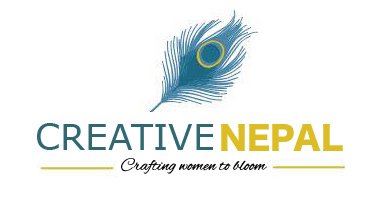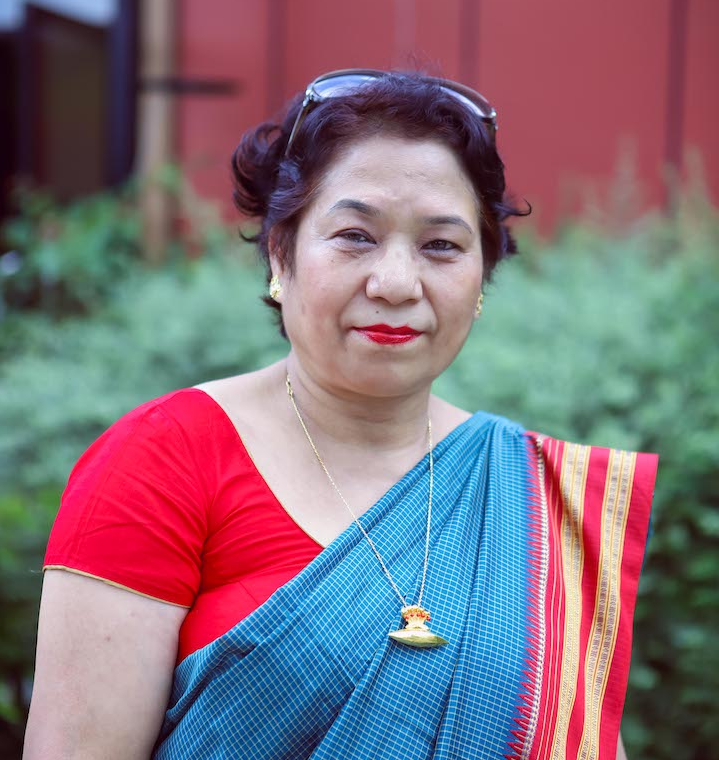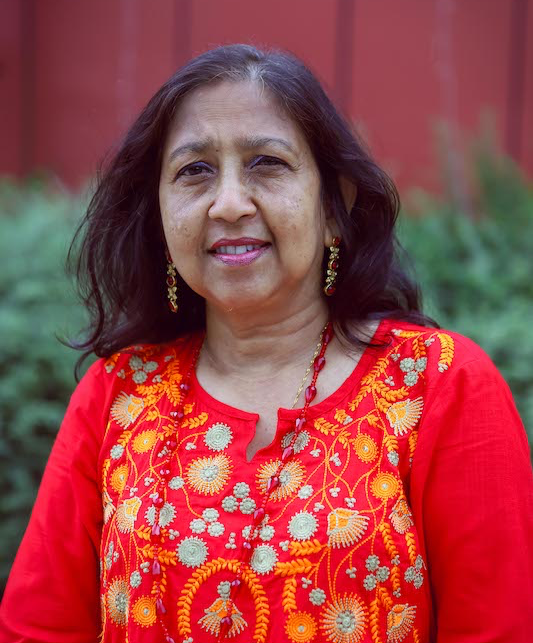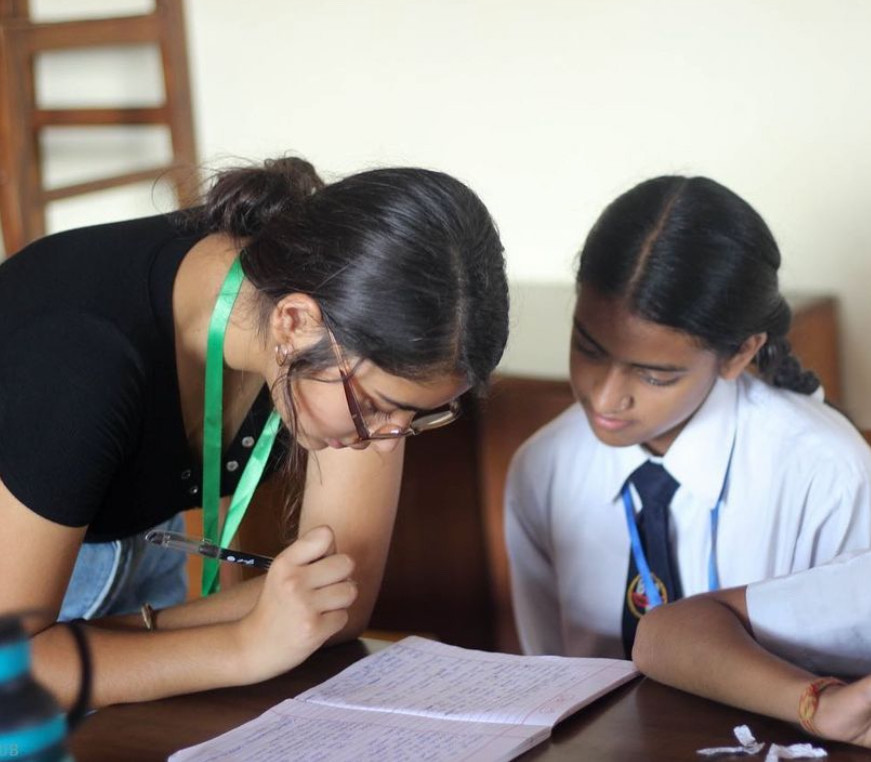
- Shop Our Products

About Owner
- About Organization
Find Us on Social Media Creative Nepal

Anita Shrestha, Founder of an NGO named Creative Nepal, using her passion (fabric) and strength (teaching) to make a difference in the lives of countless people. More than hundreds of women have lived with and more than thousands of women have learned from her, and together they combat to be independent.
She is involved in handicraft business for more than 3 decades. She spent 2 years in Japan for handicraft training and the international exposure helped her a lot to build more skills. She herself paid her own school fees by knitting sweaters at home and once she was a mother she worked hard to pay school fees for her two sons as well and since then there was no turning back for her.
With the same belief, she has been providing trainings and various opportunities for woman who think that they cannot do anything. The handicrafts made by these woman are exported in various countries as well as they are sold locally.Creative Nepal has been able to provide employement to many woman who now are able to contribute from her side to her family.

Organization
Expand its Women’s Entrepreneurial Empowerment model to train women in the world’s poorest regions for economic sustainability by 2025
Help improve the life of dependent women through income generation by producing and trading of quality clothing and other craft products with commitment to Fair Trade practices.
Current Status
Anita Amatya Shrestha, founder of Creative Nepal gives Training classes to girls in schools at Pharping and Bugmati through Fair Trade Group Nepal
Daily residential training at Creative Nepal. Training includes crafting different products with the help of sewing and weaving. Sewing and Weaving classes at schools and projects.
Creative Nepal provides training as a Resource Person. Creative Nepal sells hand woven wears for children and handicrafts.
Trained over 2500 women who are now working independently.
Our Gallery
Testimonial
After I took the training from Anita madam, I got confidence to run my own shop of sewing clothes. She is my idol. I am contributing in my children’s education.
Chaitya Shakya
I was a manager at Nepal Bank. I was always moved by the passion of Anita. After my retirement I joined Creative Nepal. Since then we work as a team for women. Her spirit convinced me not to stay home doing nothing.
Sarita Shrestha
I chose working with Creative Nepal because I believe in her passion. She empowered thousand of women which was really inspiring for me to join her in her movement.
Teju Sunwar
Before, I used to stay home doing house chores. I also took the training in Creative Nepal. Now I am full time employee at Creative Nepal and look after daily accounts of the organization.
Hema Basnet
We envision a world where women are leaders in their communities, they are in control of their own lives, their own rights, and their own decisions.

Sarita Thapa

GET IN TOUCH WITH US
Contact us for trainings, knowing our works and to buy our products.
Creative Nepal - Crafting Women to Bloom
Golfutar , Kathmandu , Nepal
Telephone : +977 1 4373501
Mobile : +977 9851079694
Email : [email protected]
© 2018 Creative Nepal. All rights reserved
Design by Sujan
School Education Scholarship
Nepalese primary and secondary education is based on the 10+2 system, where by pupils take a total of 12 years of primary and secondary education.
The grades are divided into 4 phases:
• Primary level: (grades 1-5). • Lower secondary: (grades 6-8). • Secondary: (grades 9-10), concludes in grade 10 with the SEE (School Education Examination).
• Higher secondary: (grades 11-12).
OUR STUDENTS
Anisha Bohara
Bipana Rokaya
Bikash Pariyar
Hari Basyal
Dinesh Basyal
Rajesh Basyal
Kamala Basyal
Megina Giri
Govinda Sarki
Radhika Bohara
Prince Balak
Tapras Magar
Elita Tamang
Rakesh Kumar Shahi
Rachana Devi Shahi
Ain Bahadur Rokya
Sandipa Bohara
Culture & Lifestyle

- Madhesh Province
- Lumbini Province
- Bagmati Province
- National Security
- Koshi Province
- Gandaki Province
- Karnali Province
- Sudurpaschim Province
- International Sports
- Brunch with the Post
- Life & Style
- Entertainment
- Investigations
- Climate & Environment
- Science & Technology
- Visual Stories
- Crosswords & Sudoku
- Corrections
- Letters to the Editor
- Today's ePaper
Without Fear or Favour UNWIND IN STYLE

What's News :
- BRI implementation plan
- Durga Prasai
- Wildlife conservation
- Antimicrobial resistance in Nepal
- Tourism in Bandipur

How Canopy Nepal is making a difference

Rishika Dhakal
About six years ago, while helping my cousin prepare for her grade three math exam, I noticed a glaring issue in Nepal’s education system. She struggled with a multiplication question that wasn’t in her notes, highlighting our schools’ lack of emphasis on creative thinking.
To address this problem, Mohit Rauniyar founded Canopy Nepal. Having experienced the flaws of the education system firsthand, Rauniyar aimed to promote an approach that encourages creative thinking and questioning rather than relying on rote memorisation.
The high student dropout rate and the gap between public and private schools also inspired the organisation’s establishment. “We identified two main issues: many students drop out of secondary school, and public schools often fail to provide quality education,” says Monal Bhattarai, managing director of Canopy Nepal.
Bhattarai recalls spending her vacations at the school where her grandmother taught. There, she engaged the students in educational activities and games. “I think that sparked my passion for working with students,” she says.
An educator by profession, Bhattarai joined Canopy Nepal as a facilitator six years ago. She worked her way up and now leads the organisation. Established in 2016, Canopy Nepal focuses primarily on two main areas of education: the high dropout rate of secondary school students and the lack of quality education in public schools. According to a study conducted by the organisation, 74 percent of students drop out when they reach secondary school. Income, child marriage, and labour migration have significantly contributed to the rising school dropout rate.
The education system doesn’t prioritise creativity or critical thinking. As a result, many students, especially those from underprivileged backgrounds, remain stuck in generational poverty. To address these issues, Canopy Nepal runs two major programmes: the ‘Canopy Nepal Scholarship Program’ (CANSHIP) and ‘Katha Bunaun’.
The CANSHIP programme is a long-term mentorship and scholarship initiative the organisation provides to students from grades six to twelve. “The initiative targets grade school students because many think that after taking the BLE in grade eight, school isn’t necessary anymore, leading to dropouts,” says Bhattarai. The programme also helps students understand which career paths are best suited for them.
Determined to improve the education system, Canopy Nepal also runs an annual psycho-social analysis and well-being checkup for its scholars. This assessment has helped students identify their strengths in various subjects while ensuring their overall well-being and progress.

Similarly, the ‘Katha Bunaun’ programme helps students express themselves through storytelling. It gives them the platform to share their stories and be themselves. Through this programme, the organisation has worked with over 14,000 students.
Bhattarai recalls an incident from a session in Kirtipur where a 12-year-old student wrote a story about a young girl’s abuse at home. The student switched between referring to the main character in the first and third person. When asked about the story’s inspiration, the student revealed it was based on her experience. The student had been experiencing abuse for the past two years.
“We witnessed powerful stories emerge by giving students this platform to express themselves,” says Bhattarai.
Canopy Nepal runs the ‘Katha Bunaun’ programme through multiple mediums. It has collaborated directly with schools and integrated the programme into their co-curricular activities. Similarly, in collaboration with the Kathmandu Metropolitan City office, the programme is currently running in 18 public schools within KMC.
Bhattarai says, “To enhance education quality, we run the ‘Katha Bunaun’ programme as part of KMC’s textbook-free Friday initiative, where we work with students for a whole year.” With a team of 30, the organisation supports 80 students through its scholarship programmes.
The students receive financial aid and weekly mentorship from their facilitators. These sessions allow students to discuss their friendships, relationships, and other issues. Each facilitator is dedicated to a single student, ensuring individual attention and comprehensive support. Many graduates of the CANSHIP programme secure jobs within six months of finishing high school, often earning more than their parents and breaking the cycle of generational poverty.
Similarly, several scholars have received full scholarships at prestigious universities such as New York University Abu Dhabi and the United World College.
Canopy Nepal has expanded globally, with branches in France and the US. The organisation’s founder, Rauniyar, was recognised as a Cheng Fellow at Harvard Kennedy School. Bhattarai was awarded the Global Youth Leader Award in March, a recognition that helped her build new connections and further develop the idea of Canopy USA.
Bhattarai discussed the organisation’s future goals, stating that the main objective is eliminating the student dropout rate. Additionally, she emphasised the aim of integrating ‘Katha Bunaun’ into every classroom across Nepal and introducing new learning methods.
Canopy Nepal's programme has expanded to other districts, such as Dhading, Sankhuwasabha, Gulmi, Dhanusha, Godawari, Lamjung, and Nuwakot. Currently working with the rural municipality in Dhading, the organisation aims to make education more accessible by reducing the cost of books and stationery or by identifying students who are not attending school.
The organisation works directly with schools to improve curriculums and provide additional support. So far, it has impacted over 14,000 students by improving their quality of education and enhancing self-expression and creativity.
Bhattarai says, “We especially focus on female students, as they are likelier to drop out early. We also target students from migrant families in Kathmandu, providing support to help them stay in school and succeed.”
Rishika Dhakal Dhakal is a culture and lifestyle intern at the Post.
Related News

Telling Nepal’s story

What I watch online: Manisha Thapa

The role of microbiome in skincare

Another missed opportunity in Nepali filmmaking

Addressing men’s mental health

Driven by a passion to perform
Most read from culture & lifestyle.

Pursuing her passion, stitch at a time

The untold story of a Kumari’s mental well-being

What I watch online: Shreya Shrestha
Editor's picks.

Climate change drives dengue as mosquitoes climb to new altitudes

Exports hit as India wants ‘no Chinese component’ in Nepali goods

Trump’s victory and South Asia

Complexity of transgender life in Janakpur

TIA’s reduced flight hours could stall economic growth
E-paper | november 21, 2024.
- Read ePaper Online

IMAGES
VIDEO
COMMENTS
Creative Nepal Education, Kathmandu, Nepal. 4,206 likes · 28 talking about this · 34 were here. CNE is where learning begins, as we are there to help students from their nascent stage to the time
Daily residential training at Creative Nepal. Training includes crafting different products with the help of sewing and weaving. Sewing and Weaving classes at schools and projects.
39 Followers, 61 Following, 92 Posts - Creative Nepal Education (@cnenepal) on Instagram: "Dillibazar-29, Kathmandu, Nepal +977- 9851176806, 01-4542077".
Work for the children and young with differentially able for their best care and education. We envision a world in which all young when they leave the children home has access to an education, a place to live and good nutrition, and realize their full potential, creating a better world to live in.
Creative Nepal is a non-profit organization committed creating an equal opportunity for all children, boys and girls from different Children Home with poor background in Nepal, to attain a proper education and to obtain a better future.
Nepalese primary and secondary education is based on the 10+2 system, where by pupils take a total of 12 years of primary and secondary education. The grades are divided into 4 phases: • Primary level: (grades 1-5). • Lower secondary: (grades 6-8). • Secondary: (grades 9-10), concludes in grade 10 with the SEE (School Education Examination).
CNE is an experienced education consultancy that offers personalized guidance and support to individuals and institutions.
Discover a world of opportunities! 🌐 Boost your career, make lifelong connections, and experience a new culture firsthand! 🌍📚 🎯 Why Creative Nepal Education? Personalized Guidance Global Universities Visa Support Smooth Transitions 🌟 Your Future Awaits!
The education system doesn’t prioritise creativity or critical thinking. As a result, many students, especially those from underprivileged backgrounds, remain stuck in generational poverty. To address these issues, Canopy Nepal runs two major programmes: the ‘Canopy Nepal Scholarship Program’ (CANSHIP) and ‘Katha Bunaun’.
In Nepal, our schools seldom promoted the exploration of our creative potential, and in most cases, creativity was not encouraged at all. Both parents and teachers predominantly steered...